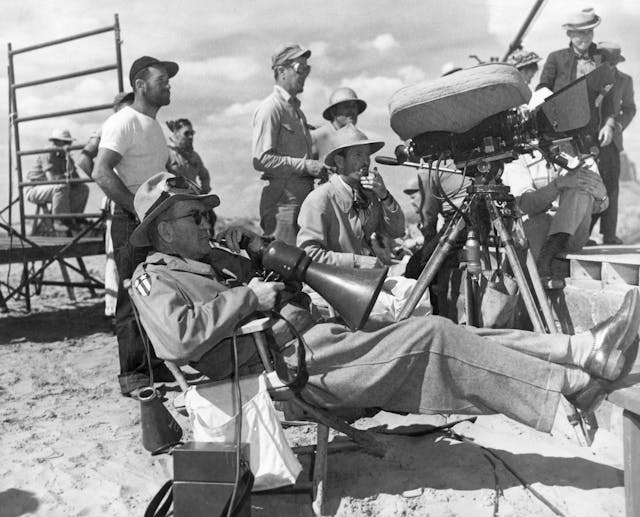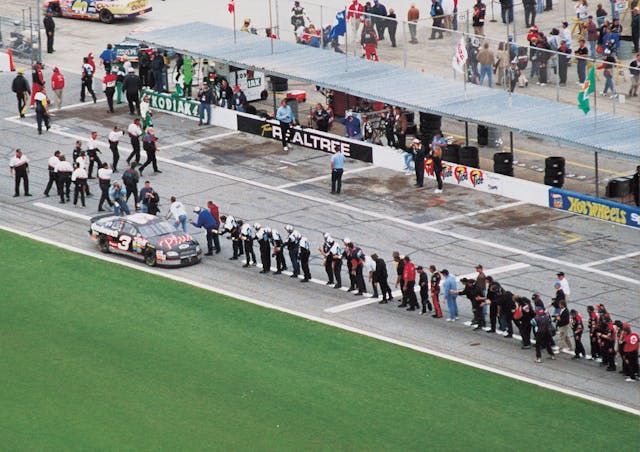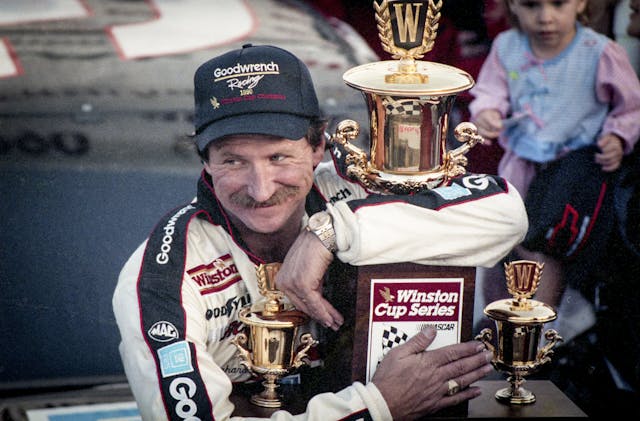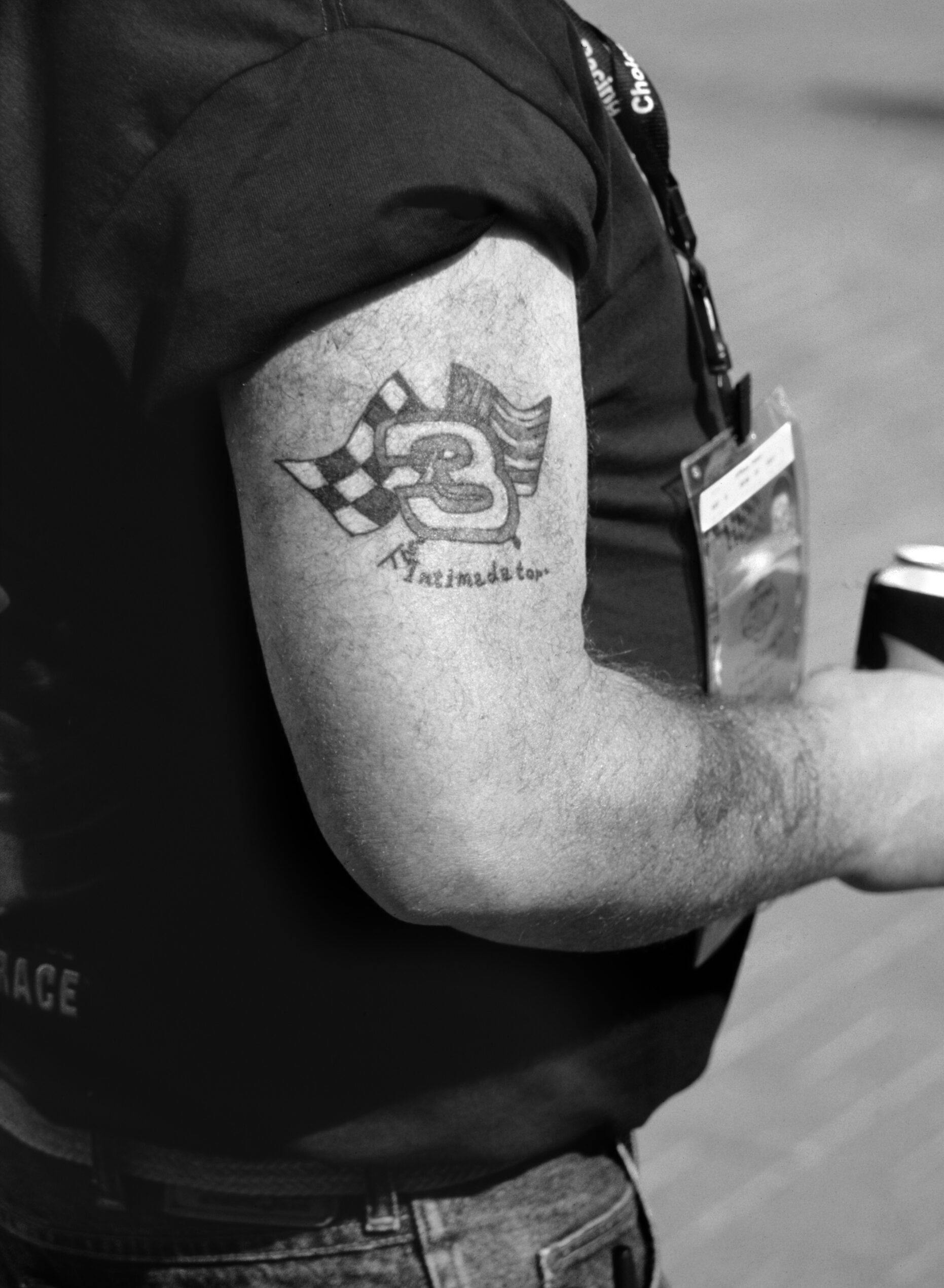Auto Anthro: Dale Earnhardt and the myth of the American West
Jack Swansey holds a degree in anthropology with a focus on car culture, and he is the world’s leading ethnographic authority (by default, if you must know) on NASCAR fandom. His love of the automobile fuels him to discover what cars mean to the people who own, drive, and love them. Read more Auto Anthro here. —EW
In the pantheon of NASCAR greats, Junior Johnson was “The Last American Hero.” Richard Petty became “The King.” Then there’s seven-time Cup Series champion Dale Earnhardt, whose 76 wins nevertheless do not place “The Intimidator” in the top five all-time. Still, somehow, the favorite son of Kannapolis, North Carolina transcended mere success in the sport. For an entire generation he was NASCAR’s villain, tragic hero, and patron saint, all wrapped into one.
The son of renowned dirt-tracker Ralph Earnhardt, Dale scrimped together just nine Winston Cup starts between 1975 and 1978 before earning a golden opportunity with car owner Rod Osterlund in 1979. He won at Bristol Motor Speedway en route to Rookie of the Year. In 1980, he won his first Winston Cup championship. In 1981, he first joined Richard Childress Racing to drive car No. 3. It was just the beginning.


As an oval-track anthropologist and NASCAR fan, I can’t help but probe the origins of The Intimidator’s mythos. How did this identity come to be? Was it his accomplishments? His personality? Something bigger?
Before we delve into these questions, we first have to talk about cowboys.
***
The heroes of NASCAR, like those of any other culture, reflect its values. And no genre was as important to early American popular entertainment than the Western.
Even before John Ford ever picked up a camera, cowboy pulp novels captured the imaginations of millions of Americans. Scholar Richard Slotkin suggests that these stories are about a symbolic frontier as much as a literal one, setting heroes of Americana between the oppressive safety of East Coast society and the unforgiving Wild West.

In these stories, when settlements pushing further westward are threatened, the hero—your Henry Fonda, Gary Cooper, or John Wayne type—must “regress” to the primal violence of the untamed West to ensure that “civilization” can survive and thrive. These aren’t accurate retellings of history. Native American characters in particular are reduced to faceless, threatening representations of the West and its resistance to control.
The narratives serve, at least according to Slotkin, to underscore an archetype upheld by a value still at the center of mainstream American culture: a willingness to sacrifice for one’s community, but not at the expense of individuality.
It’s a fine line to walk.
***
Many consider NASCAR to be the most fundamentally American form of motorsport. Its history is here, as are its fans. Cars, tracks, and drivers are wrapped in the Star-Spangled Banner. Earnhardt, like all the racing icons of old, braves the oval frontier every time he enters the starting grid. The line he walks is between death itself and the safety of staying out of the car.
Plus, Earnhardt just seemed like a cowboy. There’s nothing big-city about the Carolina boy who loved hunting and fishing. (In fact, midweek fishing trips were often the closest other drivers would get to an apology after being sent into the fence on Sunday.) His stoic persona was built on mirrored sunglasses, a bristly mustache, and the devilish smile he’d wield through his open-face helmet. Save for the jet-black Chevy, he would not look out of place alongside John Wayne aside Monument Valley.
(He was a callback to Junior Johnson’s era of moonshiners, the mold that clean-cut, rainbow-wearing, Saturday Night Live-hosting Jeff Gordon began to break in the 1990s.)

And man, was Dale Sr. tough. In 1996, he broke his collarbone, sternum and shoulder blade in a wreck at Talladega Superspeedway. Two weeks later, he put the black No. 3 on pole position and broke the track record at Watkins Glen. Reporters asked Earnhardt how it felt to lay down such a quick time and he replied, “It hurt so good.” That Sunday, he nearly won the race.
In ’97, he barrel-rolled down the backstretch fighting Gordon and Dale Jarrett for the win in the Daytona 500. From the ambulance, he noticed that all four wheels of his Monte Carlo were still attached and pointing the same direction, so he climbed back in the car, fired it up, and finished the race 31st.
Tragedy, however, is the other essential component of the frontier hero character. After every version of the shootout at the OK Corral, Wyatt Earp has to leave Tombstone, not because he lost, but because he won.
Making the West safe is the right thing to do. But heroes can’t live in the new world they create. After rubbing fenders at 200 mph, how do you go back to regular life with the volume turned so far down? Many never got the chance.
This point I want to make extremely clear: to his friends, family, and all those who knew him, Dale Earnhardt Sr. was a real person. All I seek to comment on is his mythology, and how the NASCAR community has kept his memory alive in the 22 years since that fateful February afternoon.

***
Dale Earnhardt passed away at the age of 49 from a basal skull fracture sustained in a crash in the final turn of the final lap of the 2001 Daytona 500.
Daytona already loomed large in Earnhardt’s story. At a track known to produce almost random winners thanks to the peculiarities of restrictor-plate pack racing, he won an uncanny 34 times, including setting a likely insurmountable record of 10 consecutive wins in the Twin-125 qualifying races (1990–1999).
Yet for 19 years, Earnhardt failed to win the Daytona 500. Each year, the sport’s biggest prize found new paths to slip through his fingers. He ran out of gas in 1986. Was passed late in ‘93 and ’96. Wrecked in ’97. In ‘90, he led 155 of 200 laps before cutting a tire in the final turn.
Then, after what Allen Bestwick called “20 years of trying, 20 years of frustration,” in 1998, Earnhardt finally got the monkey off his back.

Three years later, he was gone.
His death didn’t come out of nowhere. The loss of Kenny Irwin Jr. and Adam Petty the year before fueled a raging debate about mandating the head and neck support (HANS) device that Earnhardt doggedly refused to wear. The loss of the sport’s biggest icon conclusively put an end to it. While an independent investigation could not determine if wearing the HANS or a full-face helmet would have saved his life, NASCAR mandated the use of both by the end of 2001.
NASCAR immediately began to develop the safety-focused Car of Tomorrow that hit the track in 2007. It outfitted speedways across the country with SAFER (steel and foam energy reduction) soft walls. As a result of these and other changes, Earnhardt remains the most recent driver to have died in a NASCAR national series race.
As many tell it, like Wyatt Earp, Earnhardt sacrificed his whole world to make it safer for everyone else. Maybe that’s true, maybe it isn’t. That perspective certainly doesn’t capture all of him, as a whole person. Regardless, his death was a marker in time, beyond which it is impossible for a character like his to emerge again.
The frontier is in the rear-view. All we have left of it is the legend.

***
Check out the Hagerty Media homepage so you don’t miss a single story, or better yet, bookmark it. To get our best stories delivered right to your inbox, subscribe to our newsletters.





Dale Earnhardt’s death was the end of the old fan-based NASCAR. It was an end that started when Hendrick racing “cleaned up” Jeff Gordon and transformed him from a “kid having fun” racer into a slick media personality and the sport went corporate. Whether you liked Dale or not, he was a hard scrabble competitive no-nonsense racer who made the sport more exciting. RIP Dale. We miss you.
I enjoyed reading this story. Even if you are not a Nascar fan that crash will give you chills.
Dale perfected the “Bump and Run” style of driving. If you don’t move over, I’ll move you over. How do you think he got the nickname as the “Intimidator”. At first I thought he needed glasses, but then realized that was his style. Not what I would call a “good sport”!
Jack Swansey tenders historic perspective on the NASCAR mentality. Forget what you saw about the American West in movies and TV. One-fourth of all cowboys in the old American West were black. Everyone was not totin’ a gun, let alone a pair of six guns. This is like the since corrected view of cavemen who subsisted mainly on gathering and small game subduing a woolly mammoth or sabre-tooth tiger. Sheer Walter Mittyism. Gladiator games, including chariot races, go back millenia. There will always be thyroids with eye and hand coordination a cut above.
Obviously it takes skill and guts for any serious motorsport, including techniques like bump drafting. But anyone who’s been a jock knows when you’re full of adrenalin, let alone have thousands–millions– watching, you can keep going with injuries that would otherwise have you calling it quits.
Meanwhile, there’s something comical about NASCAR’s “family values” audience disregarding decals for cigarettes, alcohol, snuff, boner pills.
I remember sitting around a radio outside in the shade with my grandfather & uncles listening to the Sunday NASCAR race; long, long ago. Grandpa, Pappy he was called, raced on the dirt tracks of NC & SC for years with limited success. But, I look back upon all of that old wrenching & racing fondly as I turn wrenches in my hobby shop. Dale & JR were about the end of NASCAR for me.
This was a bit on the silly side. How an academic can confuse or be duped by marketing says a lot.
What Earnhardt was was a country boy with nothing that had a dream and drive to do what ever it takes to make it. He was broke and down and showed just about anyone can make it if you sacrifice and work hard enough. He also showed this drive while rewarding in the end did a lot of damage along the way. 3 marriages, unpaid bills in the early days etc.
What embodies Earnhardt was pointed out by himself. Travis Tritts song I’m going to be somebody about a boy that wanted to become a star singer and did what it took to make it. Dale loved that song as it described his drive.
We as fans need to stop listing to all the noise and really learn and know these people without the marketing. The cowboy deal was all dreamed up by Humpy Wheeler as I think he termed Dale one tough customer. Wrangler marketed the cowboy image back in the early years.
Dale is a bit of the American spirit where he shows that nearly anything is possible here if you are willing to work hard and sacrifice.
God knows we could use much more of this spirit today. It is what drove the settlers west in this country. My ancestors moved west in the 1700 looking for a new start and land. They faced death from a number of things and a lot of risk but they made it and I am still here today trying to carry that spirit on.
Many other countries in the world limit what you can do and they box you into your role as what ever they want. Just look at China. You don’t dare step out of line.
Dale represents the American dream and spirit in general that built this country. Cowboys were just a part of that spirit so do not confuse that no one else had it.
Life is not a John Ford movie.
Very Nicely Put Sir !! These Snowflake, Silver Spoon up there ass Kids Today couldn’t handle 10 laps with Dale at Bristol or catch him in 3 laps at Daytona or Talladega. Dale was My Hero and I Cried when Dale Died and I still cry today at the state Napcar is in.. I Stick to the Dirt Tracks of the Midwest and Florida in the Start of Year in My Late Model #66 Breeschoten Racing Engines,Veit,French Lake Motors in the Wissota and Lucas Oil Series.
There was something about Earnhardt. When I went for motorcycle rides on Sundays back then, any bar I stopped in had the NASCAR race on TV. I always knew I could check and see how old Ironhead was doing. NASCAR died when Earnhardt died. The series with their halftimes and playoffs and identical cars is just a pale shadow of what it once was.